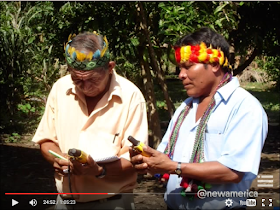The advent of social media has revolutionised the way people communicate worldwide. But in a growing number of developing countries, these tools are being put to increasingly good effect to drive agricultural and rural development, often with dramatic results. A new publication from the Technical Centre for Agricultural and Rural Cooperation (
CTA) documents the transformative power of these innovative technologies. Based on 18 case studies drawn from across African, Caribbean and Pacific (ACP) countries , Embracing Web 2.0 and Social Media: A life-changing pathway for agricultural development actors provides testimonies on how Web 2.0 and social media are contributing to better engagement of stakeholders in policy dialogue and advocacy, marketing and the provision of information services.
The
booklet documents a wide range of practical applications for Web 2.0 and social media in ACP settings. Some farmers have found that Facebook can be an excellent marketing channel to promote their products. Extension agents are discovering that social media is a highly effective way of communicating with the people they serve. Agricultural organisations are using a range of social media tools to mount advocacy campaigns aimed at influencing policy-makers. Researchers are using online collaboration tools to work on joint publications, while more and more young people are using new ICT skills to blog about important rural development issues. Others are seizing opportunities to develop innovative online services and launch their own companies as agripreneurs.
“Social media has become part of everyday life for most people in the developed world. But it has created a life-changing experience for many people in rural areas who have come to use it,” said CTA Director Michael Hailu.
All the stories featured in the booklet revolve around people who have benefited from a CTA-led campaign to make Web 2.0 and social media tools more accessible to agriculture and rural development actors in ACP countries.
The figures speak volumes: more than 4,000 individuals trained, 176 face-to-face training events – known as Web 2.0 and social media learning opportunities (LOs) – held in 44 ACP countries. In 2013, the Web 2.0 and social media LOs carried off the prestigious World Summit on the Information Society (
WSIS) Project Prize in the e-Agriculture category.
Impact assessment studies conducted by CTA have revealed that its Web 2.0 and social media capacity-building activities have led to greater inclusion and empowerment for participants, often with far-reaching repercussions for themselves and the people with whom they interact. Adoption rates are high, with young women emerging as the most likely players to adopt social media, following a training course.
In Uganda, local NGOs are using ICTs to support producers, processors and other actors in agricultural value chains. Agronomists from Madagascar are using Web 2.0 and social media to develop knowledge about apiculture. In Central Africa, a farmers’ network institutionalised social media and improved its operational effectiveness. In Samoa, a Facebook and Twitter marketing campaign is producing impressive results for women weavers of ceremonial mats. And in the Caribbean, bloggers and social media reporters are helping other young people to plan a future in farming.
“Many people have told us that the training sessions have not only changed their working behaviour, but their whole lives,” said Giacomo Rambaldi, Senior Programme Coordinator at CTA.
The official launch of the CTA publication will be held on 26 November 2015 during the International Day of Vrije University (
VU) in Amsterdam.
The booklet is available for
order in print form or for
free download from the CTA publications catalogue

